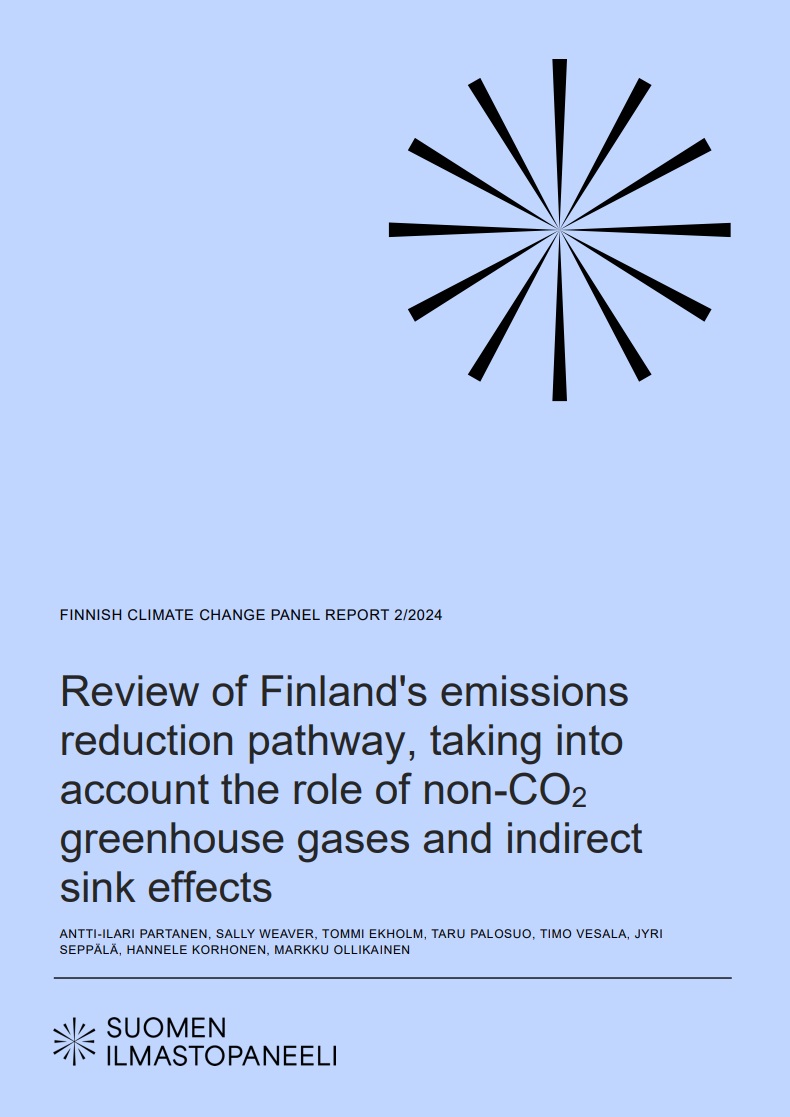The report examines how much a fair share would be for Finland to shoulder when it comes to climate actions, and the consequent emissions reduction pathway. The inventory accounting approach used by the Finnish Climate Change Panel in previous assessments is compared with approaches that are more consistent with climate science modelling and the definitions used in the Intergovernmental Panel on Climate Change’s (IPCC) scientific reports. The report takes into consideration non-CO2 greenhouse gases and indirect sink effects as part of climate modelling. The review covers the period 2020–2050. In addition to the direct application of inventory accounting as previously used by the Panel, the report proposes two emissions reduction pathways for Finland (Method 1 and Method 2), which are both in
line with the aim of a 1.5 °C limit as set out in the Paris Agreement. The results of the analysis are compared with the Panel’s earlier recommendations on the national emissions reduction pathway and carbon neutrality target. The emissions reduction pathways presented are based on linear emissions reductions, distributed evenly over the period 2020–2050.
The report looks at the impact of Finland’s greenhouse gas emissions on global warming. The starting point is an approach that follows the climate policy of the parties to the Paris Agreement: direct application of the inventory accounting approach. Following this approach, the emissions reduction pathway is calculated using net CO2 emissions from the LULUCF sector according to the greenhouse gas inventory and non-CO2 greenhouse gas emissions are reconciled to align with the remaining carbon budget in accordance with the greenhouse gas inventory. Finland’s fair share of global climate change mitigation efforts based on net emissions as detailed in the greenhouse gas inventory can be explored by looking at its fair share of the remaining carbon budget or the proportion of global warming it is responsible for. The latter approach used in the report allows non-CO2 greenhouse gases to be more accurately accounted for. Indirect sink effects, i.e. the impact of climate change and increased CO2 concentrations on managed land, are estimated based on two studies that involved forest growth on managed forest land being modelled both taking into account climate change and on the basis of the pre-industrial climate, and the difference between these simulations being used to calculate indirect sink effects.
With Method 1, indirect sink effects and non-CO2 greenhouse gas emissions are reconciled at global level. With Method 2, the same reconciliations are done at national level. In both cases, the calculation results in a lower emission budget than with the Panel’s previous method. In particular, the interpretations and results following Method 2 would require Finland to adopt a significantly more stringent climate policy in the period under consideration. Following Method 1, Finland would be carbon neutral by 2037 and following Method 2, by 2029. The primary reason for Method 1 resulting in a later date for achieving carbon neutrality than the current carbon neutrality target is the IPCC’s updated remaining carbon budget estimate. The effects of non-CO2 emissions are particularly prominent when
comparing the differences between the direct application of the greenhouse gas inventory and methods more compatible with climate science.
The conclusion of the review is that, in light of the principle of fairness based on the ability to pay, Finland’s 2035 carbon neutrality target is, at the very least, not too ambitious as a fair contribution to remaining under the 1.5 °C limit set out in the Paris Agreement. The report provides preliminary results for examining how to bring the inventory accounting approach that underpins climate policy more in line with a climate science approach.




